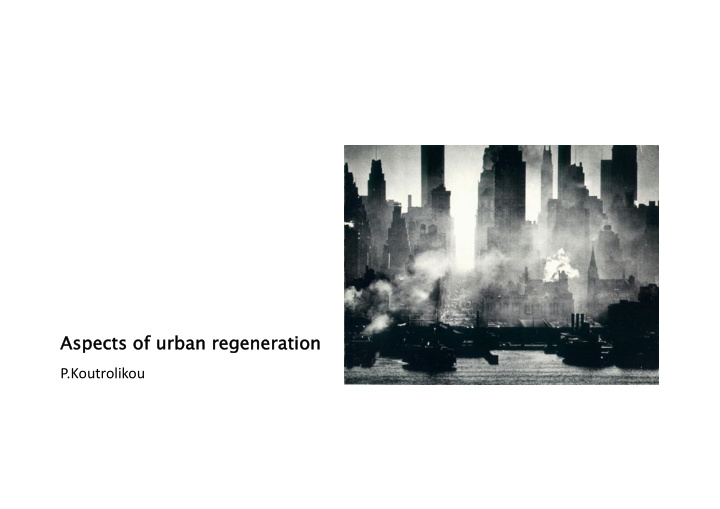



Aspects ts of urban regenerati tion P.Koutrolikou ¡
“Social ¡and ¡cultural ¡inequities ¡create ¡several ¡challenges ¡for ¡the ¡poor. ¡Appadurai ¡ (forthcoming) ¡argues ¡that ¡to ¡break ¡structural ¡inequities ¡in ¡social ¡relations ¡and ¡ achieve ¡equitable ¡development ¡it ¡is ¡important ¡to ¡build ¡the ¡“capacity ¡[of ¡the ¡ poor] ¡to ¡aspire.” ¡This ¡often ¡requires ¡organization ¡to ¡realize ¡collectively ¡what ¡ individuals ¡cannot ¡aspire ¡to ¡alone—a ¡way ¡out ¡of ¡the ¡culture ¡of ¡domination ¡and ¡ poverty. ¡Rao ¡and ¡Walton ¡(2004) ¡describe ¡this ¡as ¡building ¡“equality ¡of ¡agency,” ¡ creating ¡environments ¡to ¡equalize ¡the ¡relational ¡and ¡group-‑based ¡structures ¡ that ¡influence ¡individual ¡aspirations, ¡capabilities, ¡and ¡agency. ¡This ¡is ¡the ¡kind ¡of ¡ empowerment ¡that ¡advocates ¡of ¡community-‑based ¡development ¡envisage.” ¡ (Rao) ¡
Bringing th the city ty to togeth ther: What ¡does ¡it ¡mean? ¡ Cities ¡all ¡over ¡the ¡world ¡face ¡problems ¡of ¡ fragmentation, ¡discontinuity ¡and/or ¡polarisation ¡ (a) Uneven ¡development: ¡rapid ¡development ¡ leading ¡to ¡sprawl ¡and ¡incorporation ¡of ¡nearby ¡ areas ¡ (b) Rapid ¡urbanisation ¡leading ¡to ¡informal ¡/ ¡ad-‑hoc ¡ development ¡of ¡some ¡neighbourhoods ¡ (c) Polarisation: ¡Increased ¡inequalities, ¡increased ¡ gap ¡between ¡richer ¡and ¡poorer ¡areas ¡leading ¡to ¡ concentration ¡of ¡problems ¡in ¡deprived ¡ neighbourhoods ¡ (d) Segregation: ¡ethnic ¡/ ¡religious ¡concentration ¡of ¡ groups ¡ (e) Increased ¡fortification: ¡gated ¡communities, ¡ enclaves ¡and ¡ghettoes ¡(opposite ¡to ¡social ¡mix) ¡
Urban Regenerati tion, Renewal, Renaissance… … A ¡multi-‑disciplinary ¡approach ¡to ¡urban ¡(re) development: ¡ • ¡Existing ¡areas ¡/ ¡neighbourhoods ¡ • ¡Built ¡environment: ¡urban ¡design, ¡housing ¡upgrading, ¡ spatial ¡planning ¡ • ¡Economy: ¡local ¡economy, ¡business ¡development ¡ • ¡Socio-‑cultural: ¡welfare, ¡community ¡development, ¡ culture-‑led ¡development ¡ • ¡Political: ¡governance, ¡participation ¡ • ¡Sustainability: ¡environment, ¡long ¡term ¡planning ¡ Deprivation ¡and ¡exclusion: ¡multiple ¡factors ¡– ¡integrated ¡approaches ¡ Not ¡just ¡for ¡the ¡social ¡well ¡being: ¡Re-‑integration ¡to ¡the ¡market ¡/ ¡system ¡
Spati tial Planning “Spatial ¡planning ¡goes ¡beyond ¡traditional ¡land-‑use ¡planning ¡ and ¡integrates ¡policies ¡of ¡development ¡and ¡land ¡use ¡with ¡ other ¡policies ¡that ¡affect ¡the ¡nature ¡and ¡function ¡of ¡places.” ¡ “Spatial ¡planning ¡refers ¡to ¡the ¡development ¡of ¡frameworks ¡ and ¡principles ¡that ¡guide ¡where ¡development ¡and ¡ infrastructure ¡is ¡placed. ¡ It ¡consists ¡of ¡a ¡number ¡of ¡governance ¡practices ¡for ¡the ¡ inception ¡and ¡implementation ¡of ¡strategies, ¡plans, ¡policies ¡ and ¡projects ¡and ¡for ¡the ¡regulation ¡of ¡the ¡place, ¡time-‑frame ¡ and ¡shape ¡of ¡ ¡development. ¡(…) ¡ However, ¡the ¡practices ¡of ¡spatial ¡planning ¡are ¡not ¡solely ¡ circumstantial ¡responses ¡to ¡broader ¡forces. ¡They ¡also ¡are ¡ active ¡elements ¡of ¡these ¡changes.” ¡ Healey, ¡P ¡(1997) ¡
Concerns ¡and ¡ques-ons ¡about ¡ci-es ¡ • ¡Regenera2on ¡/ ¡Renewal ¡ • ¡Management ¡ • ¡City ¡marke2ng ¡ • ¡Public ¡Private ¡Partnerships ¡ • ¡Large ¡projects ¡– ¡big ¡events ¡ • ¡Urban ¡governance ¡ • ¡Cultural ¡development ¡ • ¡Financing ¡of ¡development ¡ • ¡Central ¡areas ¡(re)development ¡ • ¡Ci2zen ¡par2cipa2on ¡ • ¡Economy ¡ • ¡Social ¡exclusion ¡ • ¡Service ¡sector ¡development ¡ • ¡Urban ¡environment ¡ • ¡New ¡technologies ¡ ¡ • ¡Sustainable ¡development ¡
Social development t Guidelines ¡for ¡Socio-‑cultural ¡Analysis ¡Draft : ¡ • ¡The ¡identification ¡of ¡the ¡groups ¡or ¡sectors ¡involved ¡in ¡or ¡affected ¡by ¡a ¡project, ¡and ¡ the ¡analysis ¡of ¡the ¡relations ¡between ¡these ¡groups ¡or ¡sectors ¡ • ¡Achieving ¡an ¡understanding ¡of ¡the ¡culture ¡and ¡identity ¡of ¡the ¡target ¡groups ¡and ¡ beneficiaries, ¡and ¡the ¡interdependence ¡of ¡the ¡cultural, ¡economic ¡and ¡ecological ¡ factors ¡that ¡determine ¡their ¡lifestyle ¡ • ¡Engaging ¡the ¡relevant ¡groups ¡and/or ¡sectors ¡in ¡identifying ¡priorities, ¡and ¡in ¡ designing, ¡implementing ¡and ¡evaluating ¡development ¡programmes. ¡
Social development t Community ¡ Identity ¡ Welfare: ¡education, ¡health, ¡safety ¡ Local ¡ Poverty ¡ ¡ The ¡‘ community ’, ¡contrary ¡to ¡impressions ¡given ¡through ¡existing ¡guidance, ¡doesn’t ¡ consist ¡of ¡one ¡homogenous ¡group. ¡Community ¡– ¡especially ¡geographic ¡ones ¡– ¡usually ¡ tend ¡to ¡ include ¡different ¡groups ¡with ¡ diverse ¡cultures ¡and ¡ identities . ¡Therefore, ¡ social ¡groups ¡may ¡or ¡may ¡not ¡have ¡a ¡sense ¡of ¡common ¡vision ¡or ¡interests. ¡Usually, ¡ different ¡groups ¡have ¡ different ¡access ¡to ¡power . ¡And ¡naturally ¡tend ¡to ¡favour ¡ solutions ¡that ¡are ¡in ¡ their ¡own ¡interest . ¡
Cultu ture-led development t Arts ¡(and ¡their ¡spaces) ¡ Cultural ¡heritage ¡ Tourism ¡ Creative ¡Industries ¡ Cultural ¡quarters ¡ Cultural ¡trails ¡ Festivals ¡and ¡events ¡ Cultural ¡diversity ¡(ethnic ¡areas) ¡
Neighb Neighbourho urhood What ¡is ¡a ¡neighbourhood? ¡ Not ¡an ¡administrative ¡area ¡(but ¡it ¡could ¡be) ¡or ¡the ¡an ¡ area ¡of ¡the ¡“best” ¡size ¡ Rather ¡a ¡set ¡of ¡relations ¡among ¡people, ¡uses ¡and ¡ identities ¡that ¡reflects ¡a ¡feeling ¡of ¡inter-‑connection ¡to ¡ its ¡residents… ¡ Forrest ¡(2004): ¡4 ¡analytical ¡frameworks ¡about ¡ the ¡neighbourhood ¡as: ¡ Community(ies) ¡ Product ¡ Enclave ¡of ¡consumption ¡ Framework ¡
Ev Everyday life Everyday ¡life? ¡ A ¡place ¡of ¡urban ¡human ¡experience… ¡ A ¡system ¡of ¡reference, ¡a ¡range ¡of ¡social ¡ practices ¡the ¡study ¡of ¡the ¡banal, ¡the ¡ everyday… ¡ routine ¡– ¡resistance… ¡ difference ¡– ¡familiarity… ¡ time… ¡ Everyday ¡life ¡represents ¡the ¡place ¡where ¡we ¡get ¡into ¡a ¡dialectic ¡relationship ¡with ¡the ¡ external ¡and ¡natural ¡worlds… ¡and ¡it ¡is ¡there ¡where ¡the ¡basic ¡human ¡desires, ¡powers ¡ and ¡capabilities ¡are ¡initially ¡formed, ¡develop ¡and ¡realised. ¡ (Lefebvre) ¡
Everyday Urbanism (Crawford) Ev Everyday ¡Urbanism’s ¡Agenda: ¡ • ¡To ¡provide ¡alternatives ¡to ¡the ¡limited ¡scope ¡of ¡contemporary ¡urban ¡design ¡ • ¡Reconnect ¡design ¡to ¡human, ¡social, ¡and ¡political ¡concerns ¡without ¡resorting ¡ back ¡to ¡the ¡narrow ¡deterministic ¡approaches ¡of ¡past ¡architectural ¡movements. ¡ • ¡To ¡acquire ¡a ¡political ¡language ¡so ¡it ¡could ¡make ¡a ¡new ¡kind ¡of ¡personal ¡and ¡ collective ¡demands ¡on ¡the ¡social ¡order. ¡ • ¡To ¡lead ¡to ¡social ¡change, ¡not ¡via ¡abstract ¡ideas ¡imposed ¡from ¡the ¡outside, ¡but ¡ through ¡specific ¡concerns ¡that ¡arise ¡from ¡lived ¡experience. ¡ • ¡Everyday ¡urbanism ¡does ¡not ¡seek ¡overarching ¡solutions. ¡ ¡There ¡is ¡no ¡universal ¡ everyday ¡urbanism, ¡only ¡multiple ¡responses ¡to ¡specific ¡times ¡and ¡places. ¡
Recommend
More recommend